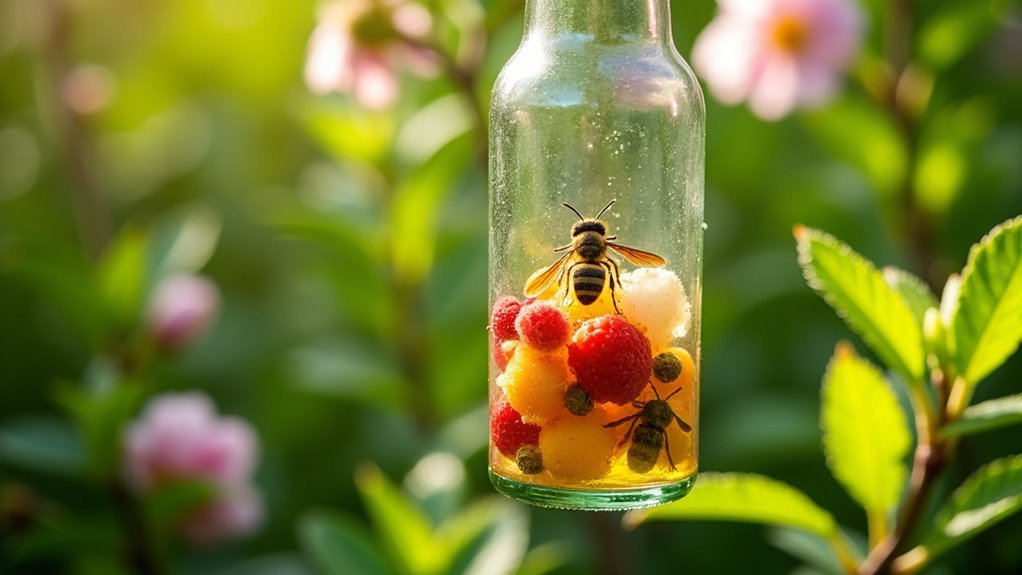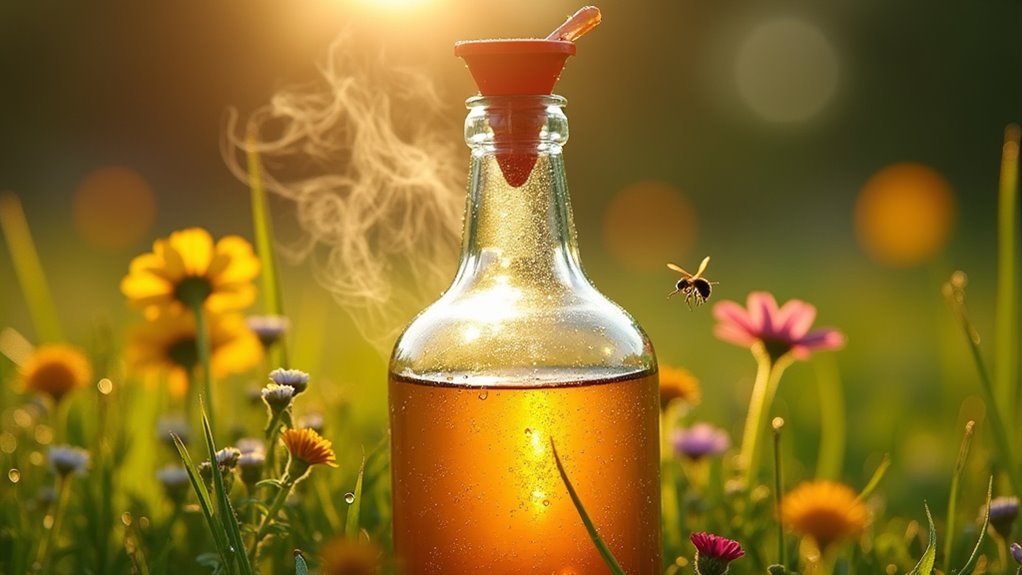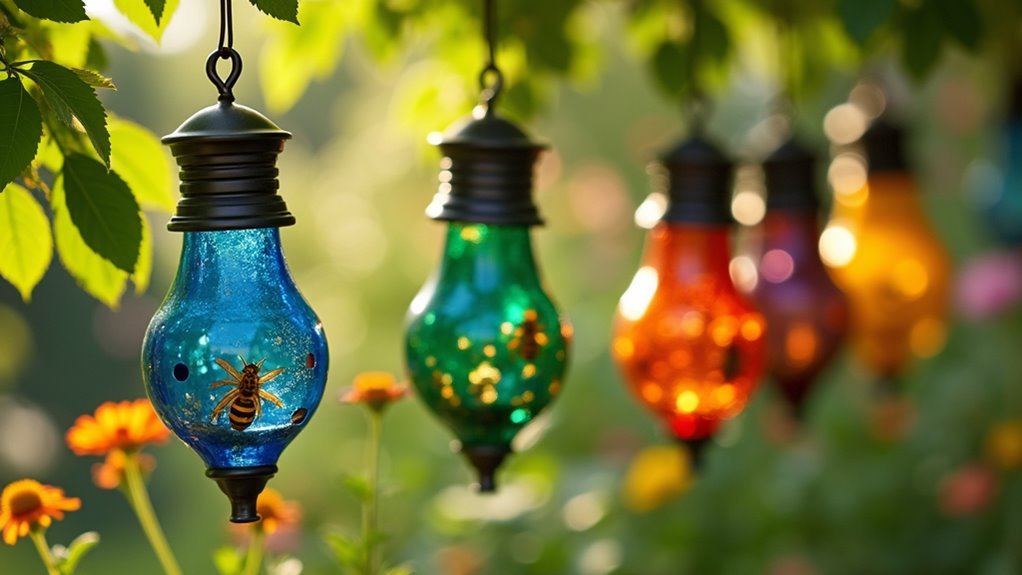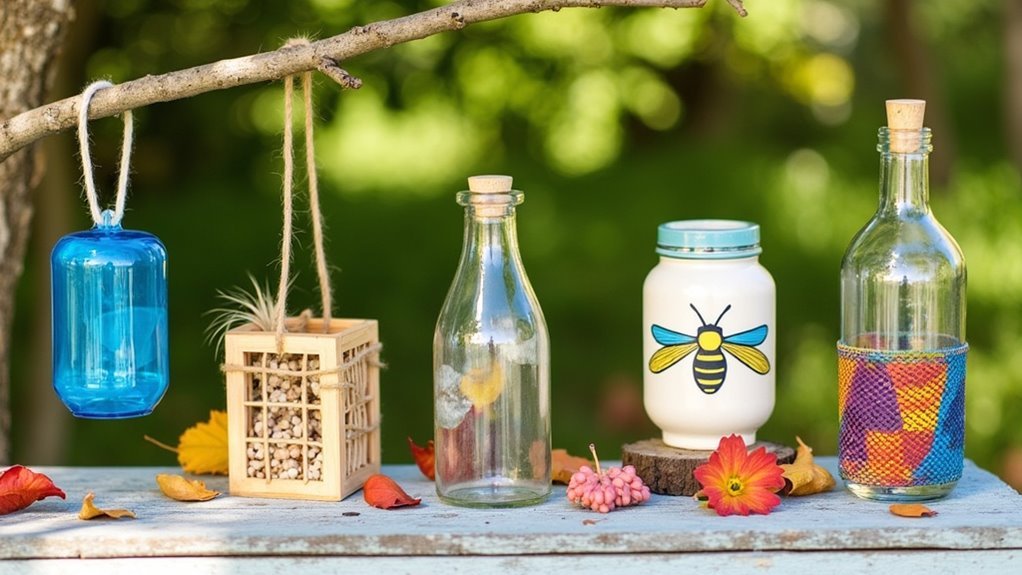You can create five seasonal wasp traps using simple plastic bottles and targeted baits. Start with protein-based traps in spring when temperatures exceed 50°F to catch queens before they lay 20,000 eggs. Switch to rancid meat baits during summer, then sugar water in late summer as wasps crave sweets. Deploy fruit-baited traps in fall before harvest season. Position all traps away from activity areas and rebait every 15-20 days for maximum effectiveness throughout the year.
Spring Queen Wasp Trap for Early Prevention

When spring arrives and temperatures consistently reach above 50°F, you’ll want to set up queen wasp traps immediately since these reproductive females are just emerging from winter hibernation and actively searching for nesting sites.
Your spring queen wasp trap serves as essential early prevention—each queen wasp can lay up to 20,000 eggs, so capturing them now will dramatically reduce future pest populations.
Create effective homemade wasp traps using protein sources like uncooked meat or ham as bait for wasp attraction.
Place these eco-friendly traps in hidden, undisturbed areas where queens prefer nesting.
Check and rebait every 15-20 days to maintain trap effectiveness throughout the season.
This proactive approach prevents massive infestations later while protecting beneficial pollinators in your garden ecosystem.
Summer Protein-Based Wasp Catcher
As summer heat intensifies, wasps shift their dietary focus from sugary substances to protein-rich foods, making this the perfect time to deploy protein-based traps that’ll effectively capture these aggressive foragers.
Your homemade summer wasp trap requires a 2-liter plastic bottle. Cut off the top, invert it into the base, and add 2 inches of protein bait like rancid chicken or spoiled tuna. These decaying proteins will attract hungry wasps seeking sustenance for their colony.
Essential maintenance steps for ideal performance:
- Add vinegar to your protein bait to deter beneficial bees
- Check trap weekly and refresh bait as needed
- Position traps away from dining areas and beehives
- Replace entire setup monthly during peak summer activity
This targeted approach exploits summer wasp behavior patterns while protecting beneficial pollinators.
Late Summer Sugar Water Bottle Trap

Late summer brings a behavioral shift in wasp colonies that changes your trapping strategy entirely. Wasps now crave sugar instead of protein, making a sugar water hornet trap incredibly effective.
Wasp behavior changes dramatically in late summer as colonies abandon protein hunting and develop an intense craving for sugary substances.
Create this simple trap by cutting off your plastic bottle’s top and inverting it into the bottom section.
Mix sugar water or fruit juice as your primary bait used to attract wasps. Add several drops of vinegar to prevent bees from entering while keeping wasps interested.
Position your trap 1.5 meters high, away from gathering areas to redirect wasps from outdoor dining spaces.
You’ll need to re-bait weekly since stale mixtures lose effectiveness and can attract unwanted insects. This positioning draws wasps away while maintaining trap efficiency throughout late summer.
Fall Fruit Garden Wasp Deterrent
During fall harvest season, wasps become relentless raiders of ripening fruit, turning your carefully tended garden into their personal buffet.
This time of year demands strategic intervention to protect your harvest from these persistent garden pests. Your homemade wasp trap becomes essential when wasps and hornets intensify their search for sugary substances.
Deploy traps before ripe fruit appears to intercept these raiders effectively.
- Bait Selection: Use mashed, overripe fruit to attract the wasps naturally
- Strategic Placement: Position traps away from harvest areas to draw hornets elsewhere
- Regular Maintenance: Replace bait weekly as wasp activity peaks
- Early Deployment: Install traps before fruit ripening begins for maximum effectiveness
This proactive approach redirects hornet attention from your precious harvest to your strategically placed decoy stations.
Multi-Season Reusable Hanging Trap

While seasonal fruit protection addresses specific harvest periods, a multi-season reusable hanging trap offers year-round wasp management that adapts to changing pest behaviors.
You’ll attract more wasps by adjusting your bait strategy throughout the season. In early spring, use protein sources to target wasp queens establishing new colonies. The best bait during summer shifts to sweet liquid like vinegar and sugar mixtures, which become their preferred food source.
Position your multi-season reusable hanging trap 6-7 meters from activity areas in trees or shrubs. This setup works great because it mimics natural nesting locations.
Rebait every 15-20 days and empty dead wasps regularly. The durable construction allows cleaning and reusing year after year, making it an environmentally responsible pest control solution that adapts from March through October.
Frequently Asked Questions
What Is the Most Effective Homemade Wasp Trap?
You’ll find the most effective homemade wasp trap uses a 2-liter soda bottle with an inverted top. Use protein baits like rancid chicken in spring, then switch to sweet baits during late summer.
Why Does Dawn Dish Soap Kill Wasps?
Dawn’s surfactants break down surface tension and penetrate wasps’ exoskeletons, causing them to lose buoyancy and drown. You’ll see it disrupts their ability to fly while leading to dehydration and suffocation within seconds.
What Is the Bait Recipe for a Wasp Trap?
You’ll mix water, vinegar, and sugar for an effective wasp bait. Use protein like meat in spring, switch to sweet liquids in summer. Add vinegar to deter bees and replace every fifteen days.
What Do You Bait Wasps With in the Summer?
You’ll attract wasps effectively with sugary liquids like sugar water, fruit juice, or soda during summer. Add vinegar to deter bees while maintaining wasp attraction, and refresh your bait weekly for ideal results.
In Summary
You’ve got five proven wasp trap designs that’ll work throughout the year. Start with the queen trap in spring to prevent colonies, switch to protein baits in summer when they’re hunting, then use sugar water as they shift feeding habits. Don’t forget your fruit garden protection in fall. The reusable hanging trap works anytime you need it. Build these traps and you’ll greatly reduce wasp problems around your property.





Leave a Reply